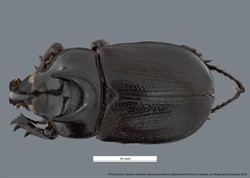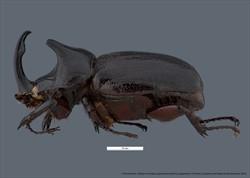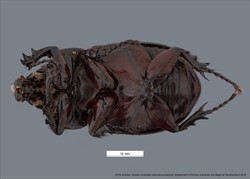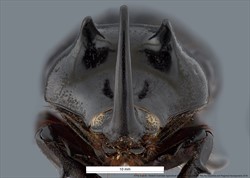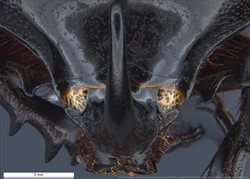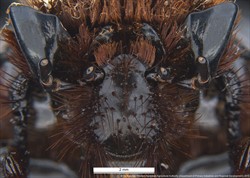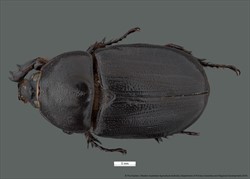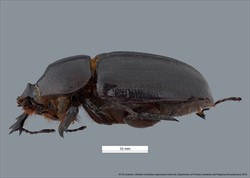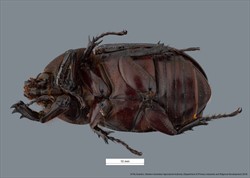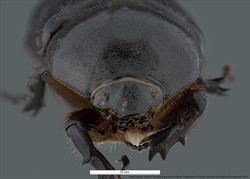Sub family: Dynastinae / Tribe: Oryctini / Genus: Scapanes
Fact Sheet
Scapanes australis Biosduval, 1835
Large, broad, cylindrical beetles. Body length 40-58mm. Body colour blackish dark brown or reddish brown. Males with a large frontal horn, recurved and with a small inner tooth near the apex. Two forwardly projecting pronotal horns, variably developed from small to very large. Females with a short bilobed tubercle on the frons, and pronotum with a broad furrow. Clypeus broad and shallowly emarginate. Antennae with 10 segments, and a compact 3-segmented club that is similar in both sexes. Labrum hidden under clypeus and highly setose. Apex of mentum broadly rounded, sometimes appearing triangular, emarginate around palpal bases and occasionally with a slight medial emargination. Pronotum with an apical membraneous margin. Mandibles axe shaped, with a narrow base and an apex broadly dialated and truncate. Elytra glabrous, punctate. Propygidium without a stridulatory area. Foretibia tridentate, metatibial apex with two long sharp spines. Foretarsi in both sexes simple, not thickened. Hind tarsal claws simple.
Scapanes australis are pests of a range of tropical crop plants including coconut palms, betel nut, sugarcane and banana. Damage has also been recorded on young oil palms.
Damage is caused by the adults feeding and damaging the growing tips by burrowing into the crown. Emerging fronds show typical V-shaped cuts. Severe damage can lead to plant death.
Scapanes australis and its various subspecies are found across South East Asia including Singapore, Indonesia, the Philipinnes, Papua New Guinea and the Solommon Islands. They are absent from Australia.
Pacific Pests and Pathogens Fact Sheet: http://www.pestnet.org/fact_sheets/coconut_rhinoceros_beetle__melanesian_057.htm
PaDIL Image Set: http://www.padil.gov.au/pests-and-diseases/pest/main/135965
Plantwise Fact Sheet: https://www.plantwise.org/knowledgebank/datasheet/49241
Endrödi, S. 1985 The Dynstinae of the World. W. Junk. London. 800pp.

